If quantum mechanics really allows nature to act at a distance, does that open a door to faster-than-light (FTL) communication—or is the door sealed by the famous “no-communication theorem”? A growing group of physicists and philosophers argue that we’ve mistaken the lock for the doorframe. By re-examining what counts as an observable—and how we actually measure time—they claim we can design practical, laboratory-testable protocols that transmit information superluminally without contradicting any laboratory facts about quantum theory.
Why “FTL Quantum Communication” is back on the table
Quantum communication is already a real field: entanglement distribution, quantum key distribution, and quantum repeaters are advancing rapidly. But these all respect the light-speed limit for useful signaling: you need a classical, lightspeed channel to compare measurement records. The “no-communication theorem” looks like a mathematical stamp on that limit.
A group of researchers—including philosopher-physicists Kent Peacock and Tim Maudlin, and quantum theorist Siddhant Das—argue that this stamp depends on assumptions we rarely inspect. In particular, the theorem presumes a specific catalog of allowable transmitter actions and receiver observables. If either catalog is expanded in a physically sensible way, the theorem’s conclusion can fail. As Peacock summarizes, standard no-signaling proofs often rely on ad hoc restrictions rather than ironclad physical principles.
The most concrete reopening of the debate comes from new work on arrival-time measurements—literally timing when a quantum particle hits a detector. This deceptively simple observable turns out to be a pressure test for the foundations of quantum theory, and it has a direct, testable path toward FTL signaling proposals. A 2022 Scientific American feature chronicled how a Munich-based team used Bohmian mechanics to make precise, experimentally discriminable predictions for arrival-time distributions—a quantity that standard quantum mechanics struggles to define cleanly.
“Normal quantum theory is concerned only with where; they ignore the when.” —Siddhant Das, on the foundational problem of arrival times.
What exactly does the “no-communication theorem” forbid?
Physicists often summarize: “Entanglement can’t be used to signal FTL.” But that summary hides a crucial if. The classical presentation considers two distant labs (Alice and Bob) sharing entangled pairs. If Alice chooses one of several permitted measurements and Bob reads out one of several permitted observables (all represented by standard Hermitian operators), then Bob’s local statistics don’t depend on Alice’s choice. Therefore—under those assumptions—no message crosses space faster than light.
Das offers a crisp way to see the scope of the theorem: even if Alice repeats her choice (e.g., always measure along X for a “1” or along Z for a “0”) over many runs, Bob’s histograms remain indistinguishable provided he is restricted to the usual menu of quantum observables. That indistinguishability is the theorem’s content.
Maudlin emphasizes two often-confused points. First, Bell’s theorem shows that local explanations cannot reproduce quantum correlations—nonlocality is unavoidable. Second, nonlocality need not imply superluminal signaling, but ruling signaling out “in principle” requires care: you must say exactly what a transmitter is allowed to do and what a receiver is allowed to observe. If you alter either side sensibly, the classic no-signaling proof may no longer apply.
“If either [the transmitter action or the receiver observable] changes, then Bell’s proof doesn’t apply.” In particular, arrival time is something you can observe for which there is no standard Hermitian operator.
Peacock goes further: many “no-signaling” arguments assume, rather than derive, that distant subsystems cannot dynamically influence each other through entanglement—an assumption suspiciously tailored to achieve the desired result.
The timing problem that undermines the status quo
Here’s the crux: standard quantum mechanics lacks a universal time-of-arrival operator. Pauli’s famous argument showed that a naive “time operator” doesn’t fit the usual operator framework. In practice, labs do time-of-flight physics every day (e.g., mass spectrometry, collider detectors), but the modeling quietly mixes classical and quantum steps, or makes supplemental assumptions that work only in special cases.
A striking technical headache is the quantum probability current (“quantum flux”). In near-field settings or with particular spin configurations, it can become negative—implying negative “probabilities” for arrival times, an obvious impossibility. In those regimes, standard methods are silent or inconsistent. Bohmian mechanics—where particles have definite trajectories guided by a wave function—keeps making clean predictions, including sharp cutoffs in arrival-time distributions that other approaches lack. That means experiments can decisively test which framework gets time right.
A proposed setup is conceptually simple: prepare a particle in a waveguide with a potential well, “release” it at a known moment, and record the arrival time at a distant detector over many trials. The distribution of arrival times depends sensitively on the particle’s spin orientation relative to the guide, and Bohmian predictions diverge from semiclassical and quantum-flux approaches in exactly the regimes where flux turns ill-defined.
From timing to Quantum Communication: a loophole with teeth
Das’ key insight is to drop the assumption that Bob must measure a standard, operator-represented observable. Instead, let Bob measure arrival time—an operationally well-defined quantity without a standard Hermitian operator. Then, entanglement can correlate Alice’s choice of spin measurement (e.g., X vs. Z) with different arrival-time histograms on Bob’s side, even though each individual detection time remains random.
Sketch the protocol:
-
Share entangled electrons. Alice is the transmitter, Bob the receiver.
-
Alice encodes a bit by measuring her spin in basis X (say “1”) or Z (“0”) on a block of many pairs.
-
Bob traps and releases his partner electron toward a detector and logs arrival times; he constructs a histogram per block.
-
Decode by distribution. If the “X” and “Z” choices produce measurably different arrival-time distributions at Bob, then Bob can infer Alice’s bit from his local data alone, with some error rate, i.e., true FTL Quantum Communication in the Shannon sense.
“If Bob were to do arrival-time measurements … he will see differences whether Alice was trying to send a 1 or a 0. And this will happen at spacelike separation.” —Siddhant Das
You don’t need perfect, noiseless runs; you just need the distributions to differ enough for Bob to improve his guess about which “button” Alice pushed—the Shannon criterion for information transfer. As Maudlin notes, once we state clearly what the transmitter can vary and what the receiver can observe, the question of signaling becomes an empirical one. If an observable like arrival time sits outside the standard operator catalog but is transparently measurable, the classic no-signaling proofs don’t bind us.
Is this really FTL? And what about relativity?
Relativity teaches there’s no frame-independent notion of “instantaneous.” What matters operationally is whether Bob can infer Alice’s choice outside each other’s light cones—spacelike separation. In some frames a successful protocol looks instantaneous; in others merely superluminal; in still others it looks retrocausal. That’s not new: any FTL influence implies frame-dependent time order. As Maudlin stresses, physics must distinguish causation from signaling and be explicit about what each theory forbids.
A genuine FTL signaling protocol would force a deep conversation about how quantum nonlocality nests inside spacetime. Possibilities include:
-
Preferred foliation / time-ordering: Some nonlocal realist approaches (e.g., certain Bohmian formulations) effectively use a hidden “universal time” for dynamics while keeping all observable Lorentz-covariant predictions.
-
Operational constraints: Even if FTL signaling is demonstrably possible in special protocols, it may be limited to resource-intensive, short-range, or delicate laboratory conditions that don’t enable paradox-inducing loops.
-
Information-theoretic consistency: As long as the physical channel is noisy and resource-bounded, standard “send-your-grandfather-a-text” paradoxes may remain unreachable in practice.
These are live research questions rather than conversation-stoppers. The philosophical move Peacock warns against is to elevate a provisional modeling assumption into a universal law. Let the lab decide.
How to test now (and why the test matters even without FTL)
Critically, the first milestone has nothing to do with Mars rovers or interstellar chat. It’s to nail the one-particle arrival-time statistics in regimes where theories disagree—near-field geometries, guided electrons, and spin-dependent initial states. Das recommends exactly that sequencing: before attempting an entangled two-lab protocol, run high-precision single-particle timing experiments to validate which theory gets time right. If Bohmian predictions with spin-dependent cutoffs match the lab, that alone would be a foundational shock.
The good news: this is feasible table-top physics. Prepare an electron in a trap at one end of a waveguide, release it at a marked time, and record when it hits a distant detector—repeat thousands of times to build a distribution. The LMU team mapped concrete parameter regimes where predictions diverge sharply and where quantum-flux methods fail due to negative probability current. That gives experimentalists a roadmap to falsify whole classes of assumptions.
If those timing distributions differ exactly as Bohmian mechanics predicts, then the second milestone is to couple two labs and check whether Alice’s choice alters Bob’s arrival-time histograms at spacelike separation. Either way, science wins:
-
No difference: You’ve discovered a dynamical reason (beyond the algebra of density matrices) that enforces no-signaling even with non-operator observables.
-
A difference: You’ve demonstrated FTL Quantum Communication in Shannon’s sense, forcing a principled revision of how we fuse quantum theory with spacetime.
Engineering reality check: noise, errors, and resources
Even proponents caution against overpromising. Maudlin, for example, doubts any of this will “make your cell phone work better.” A successful demonstration would be a foundational milestone, not a consumer product roadmap. But it needn’t be a unicorn either: if the distributions are distinct enough, block-coded bits could be transmitted at low rates and modest error probabilities, exactly as early classical telegraphy dealt with noise.
In practice, a working system demands:
-
Stable sources of entangled electrons rather than photons (because the key timing effects appear for matter waves with spin, not for light in the same way).
-
Spin preparation and control aligned with the guide axis to enter regimes where predictions separate.
-
High-resolution timing with jitter well below the distribution differences.
-
Strict spacelike separation and event-timing synchronization (GPS-disciplined clocks; relativistic separation verification).
These are demanding but not exotic requirements for modern atomic, molecular, and optical (AMO) physics labs.
Does this “break” physics—or fix a blind spot?
Einstein’s deepest worry about quantum theory was nonlocal action, not just signaling. Post-Bell, nonlocality is with us whether or not we can send FTL messages. The right question is whether the no-communication principle is a basic law of nature or a convenient artifact of the textbook observable set. If arrival-time observables are legitimate—and every experimentalist treats time-of-flight as legitimate—then the burden is on theory to explain why they should be excluded from the signaling conversation.
“What matters is to characterize what the transmitter can do and what the receiver can see. Until you do that, you can’t even ask if communication is possible.” —Tim Maudlin
Peacock’s caution applies: if a “no-go” depends on a modeling patch, don’t mistake the patch for a principle. Let the lab decide.
A clear call for decisive experiments
The best part of this debate is that it has left the armchair. A carefully engineered sequence of Quantum Communication experiments—first single-particle arrival time, then entangled-pair histograms—could within a few years either (a) reinforce no-communication by locating the true dynamical barrier, or (b) demonstrate a narrow but undeniable path to FTL signaling. Either outcome would sharpen our understanding of quantum theory and its fit with spacetime.
And if the latter happens? Don’t expect intergalactic Zoom tomorrow. But do expect a renaissance in both quantum foundations and quantum engineering—one that treats time not as a bookkeeping convenience, but as a first-class observable we can measure, model, and (perhaps) use.
Notes & sources used in this article
-
Tim Maudlin, FTL Quantum Communication & Non-Locality, Tim Ventura Interviews, Sept 26, 2022
-
Siddhant Das, “FTL Quantum Communications & No Communications Theorem“, Zoom, Jan 17, 2025
-
Kent Peacock, “The No-Communication Theorem Is Wrong“, Tim Ventura Interviews, Sept 20, 2022
.png)




